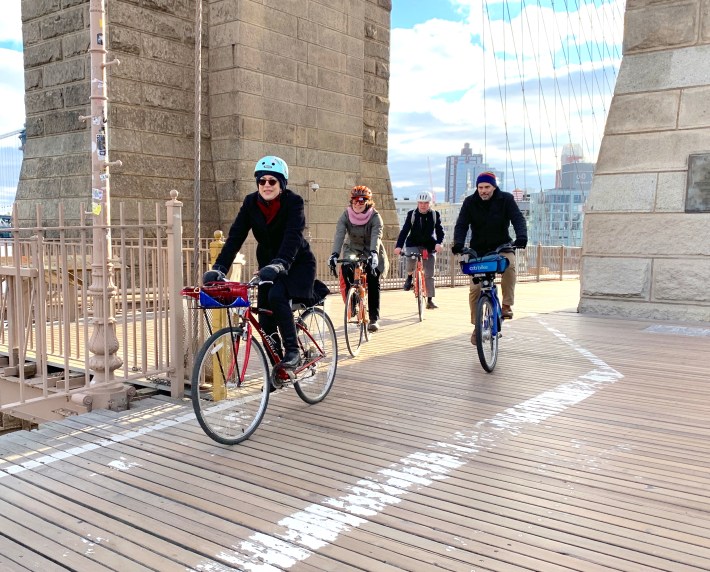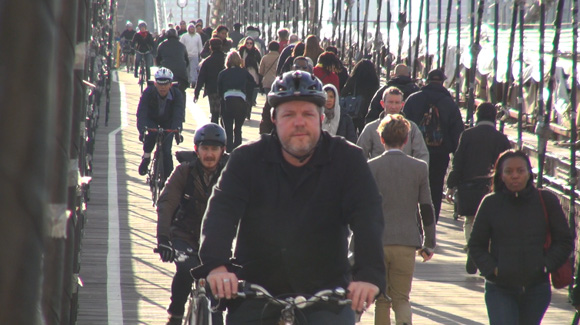The victim of a 2017 bike crash on the notoriously overcrowded Brooklyn Bridge has just won a $75,000 settlement after suing the city — and the court’s decision is proof that the Department of Transportation must immediately create adequate space for cyclists and pedestrians on all East River spans, according to the attorney representing the victim.
Lawyer Dan Flanzig, representing the victim of the Dec. 6, 2017, crash, said that the settlement last month shows that the city can no longer ignore well-known conditions on the bridge — where pedestrians and cyclists must share one narrow pathway, with one side designated for bikers and the other for walkers.
“During this pandemic, now more than ever, the city needs to acknowledge the need to create safe infrastructure for cyclists who will be commuting into Manhattan by bike,” said Flanzig. “Overcrowding of our bridges can be addressed by dedicated and protected bike lanes which discourage entry and use by pedestrians. At the same time, dedicated space can and should be created for pedestrians to avoid any dangerous conflict between these two groups.”
Flanzig says his client, Carolea Goldfarb, an attorney at the Kings County District Attorney's office, was knocked off her bike while commuting to work after a tourist walked into the bike lane. The victim, who fractured her hand, requiring surgery, sued the city and was just awarded the $75,000 settlement.
As part of the city’s deposition on Jan. 3, 2020, Hayes Lord, a senior transportation manager for the Department of Transportation, admitted that agency honchos are, and have been, aware of the dangerous conditions on the bridge.
Only in 2018 — one year after Goldfarb's crash — did DOT study the feasibility of installing additional delineators between the bicycle lane and the pedestrian lane near the busy Brooklyn staircase.
“Despite its own studies, the city had and still has failed to institute a plan to make the bridge safe for all users,” said Flanzig.

In fact, Lord said he had even given prior testimony in another case involving a similar crash where “a pedestrian crossed in front of a cyclist," but still no changes had been made after that. Since 2009, there have only been “minor updates” to the design meant to steer pedestrians towards one side of the bridge and cyclists in the other, including adding bike symbols and additional delineators on just one small stretch of the span.
“As I stated previously the only changes that were made were in the updates to the adding bike symbols or pedestrian symbols and adding delineators,” Lord said during his testimony.
The city's paint jobs fade quickly, thanks to crowding on the bridge, and were likely insufficient on that morning in 2017 when the victim was thrown off her bike. Lord testified that he doesn’t recall any time between 2016 and early 2018 when the markings had been refurbished.
“If I recall correctly due to the lateness of the season it was not completed within that year,” he said.
Lord also testified that DOT does not do any type of inspection on a regular basis to see whether or not the paint has worn away and needs to be refurbished more frequently.
This case only reinforces another landmark decision from 2017 when New York’s highest court, the Court of Appeals, ruled that New York City can be held liable for failing to redesign streets with a history of traffic injuries. That decision stemmed from a 2004 crash, when Louis Pascarella, driving “at least” 54 miles per hour in a 30 mph zone, struck 12-year-old Anthony Turturro as he rode a bike on Gerritsen Avenue. Pascarella later pled guilty to assault.
Turturro won a $20-million settlement against the city. On appeal, the high court ruled 6-to-1 in favor of Turturro, setting a precedent that the city cannot ignore known dangerous conditions.
Attorney Steve Vaccaro, who also represents traffic crash victims, said at the time that the decision was a "game-changer."
“The court held that departments of transportation can be held liable for harm caused by speeding drivers, where the DOT fails to install traffic-calming measures even though it is aware of dangerous speeding, unless the DOT has specifically undertaken a study and determined that traffic calming is not required," Vaccaro said.
At the start of 2020, Department of Transportation Commissioner Polly Trottenberg apologized for the latest delay in fixing dangerous conditions on the Brooklyn Bridge bike and footpath, despite Streetsblog's own advice offering five ways to make it safer. And in June, DOT had hinted that it might now consider a bike lane on the roadbed of the fabled span itself — though Trottenberg dismissed the idea out of hand.
But shy of any major, and likely pricey, redesign of the bridge, the city should at least ensure that the markings are clear and visible to keep pedestrians and cyclists separated and safe, said Flanzig.
"This isn't a complicated and expensive fix — it's bollards and paint," he said.
Crash statistics are not available for the bridge, but in the pre-COVID months, when pedestrians, tourists, cyclists and vendors crowded the roadway, social media was repeatedly filled with reports of crashes.
And last month, another cyclist was thrown off his bike after a photographer snapping photos for a proposal on the bridge stepped into the bike lane right in front of the oncoming cyclist, sending both of them crashing to the ground in a now-viral video.
This story has been updated with the exact sum of the settlement, and the victim's name.
Streetsblog has reached out to the Department of Transportation and city Law Department for comment and will update if we hear back.






